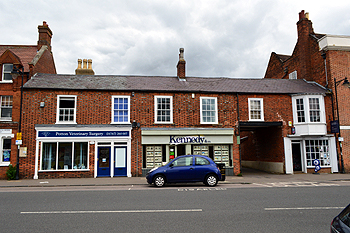The George Inn Potton
The George Inn: 9-11 Market Square, Potton

9 to 11 Market Square August 2013
As can be seen from the references below, the George was clearly an old building. The first reference we have to it is as early as 1581 [S8] when the court roll of the Manor of Potton Much Manured notes that John Faldo had devised an inn called the George in Potton to his son Robert
The inn was clearly an important part of the life of the town as it is referred to as a great inn in 1703 when it was owned by the Burgoyne family as lords of each of Potton's four manors (Burdetts, Much Manured, Regis and Rectory) [W2089] and included in a marriage settlement between Roger, son of Sir John Burgoyne, baronet and Constance, daughter of the late Sir Thomas Middleton. The inn was held from the manor along with ten acres of meadow and fifteen acres of arable by Francis Cotton at a rent of £42/13/4.
On 21st February 1780 the following advertisement appeared in The Northampton Mercury: To be LETT, and Entered upon immediately, All that Capital MESSUAGE, or INN, called or known by the Name of Sign of the GEORGE, situate in the Market-Place of POTTON, in the County of Bedford; together with the Yards, Barns, Stables and Shops belonging to and now used with the same. And also all those 152 Acres (Statute-Measure) of Arable-Land, Meadow and Pasture-Ground (110 Acres whereof is inclosed) lying in Potton aforesaid, now also used and occupied with the said Inn and the same are now in the tenure of Occupation of Richard Emery and is Assigns. For further particulars enquire of Mr. Joseph Cole, of Shefford, in the said County of Bedford. The House is very advantageously situated for good Business, and the Effects and Stock in Trade may be had at a fair Appraisement".
The inn was destroyed in the Great Fire of Potton of 14th August 1783. In 1784 a book was published (a copy of which is in Bedfordshire & Luton Archives & Records Service searchroom library) called: The General Account of the Losses and the State of the Collections and Distributions on Account of the Fire Which happened at Potton in the County of Bedford. The account notes the name of each person losing money by the fire, their profession and the amount lost (after insurance money), the following are included:
- Hannah Carter, servant to Mr.Smith at the George: £1/2/-;
- Elizabeth Rowney, servant to Mr.Smith at the George: £1/4/6;
- John Smith, innholder and farmer: £704/13/2.
It seems likely that John Smith succeeded Richard Emery. His losses are the eighth largest as one might expect if a large proportion of the inn and therefore its stock of alcohol was destroyed, not to mention loss of trade. It is known that the majority of buildings in the Market Square, save for the west side, were destroyed. A map of 1813 [W2/10] shows part of the Market Square and identifies a property, set well back from street as being in the George Yard. This frontage corresponds to today's 9, 10 and 11 Market Square which were not built until later in the century clearly suggesting that the George itself had stood on the frontage they occupy today. Additional evidence for the death of the George in 1783 is that today's George and Dragon (itself built on the site of an inn called the White Hart) was called the George in early 19th century documents and there would clearly not be two inns on the same name so close together.
References:
- S8: will of John Falco: 1581;
- W2089: marriage settlement: 1703;
- X439/45: mortgage: 1735;
- WG200/30: will witnessed at the George: 1730;
- W2103-2107: transfer of mortgage: 1747;
- W2103-2107: mortgage redeemed 1752;
- Northamptonshire Mercury: advertisement to let inn: 1780;
- W2/10: The George Yard shown on a map of 1813.
List of Licensees: note that this is not a complete list. Italics indicate licensees whose beginning and/or end dates are not known:
1703: Francis Cotton;
1752: Edwards;
1780: Richard Emery;
1783: John Smith.